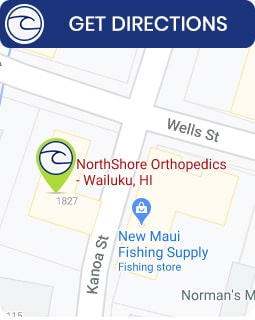Platelet-Rich Plasma (PRP) Injections Clinic in Maui, Wailuku, HI
If you are suffering from chronic pain in your joints and traditional treatments have not worked well for you, visit The Northshore Orthopedics today to schedule a consultation for PRP therapy. Our experienced and board-certified orthopedic surgeon Dr. Charles Soma, MD can help you decide whether PRP treatments may be right for you, and help you design a treatment plan that is tailored to your individual needs. Contact us today or schedule an appointment online. We are conveniently located at 1827 Wells St #1, Wailuku, HI 96793.


Table of Contents:
What does PRP do?
How long do PRP injections last?
What is the success rate of PRP injections?
How often should PRP be done?
What is platelet rich plasma?
How can platelet rich plasma therapy help an injury?
How long does it take to see results?
At NorthShore Orthopedics, our team of orthopedic specialists offers the newest and most effective techniques on the market to patients of all ages. While surgery and medications are a great solution for some orthopedic injuries, such as bone fractures or immediate pain relief, they can sometimes be a second option for certain injuries. One increasingly popular way to aid in tissue recovery and cartilage growth is PRP therapy or platelet-rich plasma therapy. This technique has been proven to work for many patients and is fast, easy, and safe to administer. At NorthShore Orthopedics, we have an experienced team of orthopedic professionals who have been administering PRP therapy for years and can provide you with a friendly and professional medical experience at our clinic in Wailuku. We know that finding the right solution for your orthopedic problem can be difficult, which is why our team at NorthShore Orthopedics works hard to give you the results that you are looking for. Our experienced orthopedic surgeon, Dr. Soma, can administer PRP therapy in the comfort of our state-of-the-art Wailuku clinic.
Platelet-rich plasma injections, otherwise known as PRP injections, are injections of blood with a higher concentration of platelet than the average sample of blood plasma. The technique promotes quicker and improved natural healing of the body, making it among the most widely used regenerative medicine options. The injection of PRP is able to release growth factors, which are specific proteins, that increase the activity of cell proliferation, tissue regeneration, and other significant aspects of the healing process. PRP is most known as a viable option for athletes dealing with injuries, as well as individuals struggling with hair loss, but may also be utilized for more general post-surgical healing, osteoarthritis, and even anti-aging. Put concisely, PRP is an established treatment option or aspect with a variety of applications that utilizes a person’s blood to promote or enhance healing, or bodily function.
Injections of PRP typically last around 6 months, with an upper bound of around 9 months, however, one must acknowledge that the exact duration may vary. Despite this, to prolong the effectiveness of treatment, a physician will generally give specific instructions to follow. For PRP injections regarding orthopedic instances, these instructions emphasize resting, not consuming or indulging in certain habits for some time, avoiding certain medications and may mention physical therapy, or the use of support instruments if needed. Most often, treatments involving PRP consist of 2-3 sessions of injections appropriately spaced out. Chronic cases are likely to need multiple series of these injections to see long-term relief whereas acute injuries or conditions may not necessarily need as many sessions. Because of this, it is fundamental to consult with a physician well-versed in PRP injections to ensure it is an acceptable treatment option and help monitor the progression of treatment.
The success of PRP injection treatment will appear different depending on the circumstances and goals of the treatment due to the versatile nature of PRP injections. Regarding solely orthopedic instances, the success of the treatment may be defined as the following results: reduction of pain, improved functionality of the body, quicker recovery, and patient satisfaction. Knowing this, it is correct to say that PRP may be an effective aspect of treatment for both acute and chronic conditions and injuries. For acute instances, one may expect to see a quicker and enhanced healing period while those with chronic conditions may expect the benefit of pain reduction or increased mobility. In one such study on the effectiveness of PRP on tennis elbow, 84% of patients expressed their pain to be reduced by 25% or greater after 24 weeks with many other conditions showing comparable, or slightly more effective conclusions. Due to the versatility of PRP, it is essential to shift perspective on the goals depending on the condition at hand, and with that being said, physicians will help determine the goals and expectations of PRP for an individual’s specific circumstances.
It is standard that PRP injection therapy consists of 2-3 injections spaced anywhere from 4-6 weeks apart, with the treatment lasting approximately 6 months. Despite this, it should be understood that the versatile nature of PRP injections may mean that this treatment structure is less rigid. For example, the severity and type of a condition as well as a patient’s health may mean a different schedule is best. In many cases, a physician will start with a schedule, such as the one listed above, and monitor the condition’s progression as well as the body’s response to treatment to determine if an alternate option is necessary. For chronic injuries and conditions, to achieve long-term results, individuals are more likely to have to undergo multiple series of PRP injections while for acute conditions, it is more likely for only one series or injection to provide adequate results. So, while there is certainly a picture of the average intervals of PRP injections, it is a flexible variable and may be altered if a physician deems it appropriate.
So what exactly is PRP therapy? We first begin by collecting a small amount of the patient’s blood, and then place it in a centrifuge to separate the platelet-rich plasma from the rest of the flood. These collected platelets are then injected into the injury site, and the growth factors within the PRP stimulate repair in the area. By increasing collagen levels, stem cells recover and can lead to more resilient and firm cartilage. While it can take a few weeks for results to happen, many patients report increased mobility and pain relief after receiving PRP therapy. The entire process takes only about 20 minutes and relief can last for 6-9 months for some patients. Many tendons or ligament injuries can be treated successfully with PRP, and it is a great option for those patients who would like to try something before an invasive surgical procedure. Because the PRP therapy procedure uses your blood, it is completely safe and sanitary.
At Northshore Orthopedics, our goal is to provide our patients with access to cutting-edge, effective treatment options that can help them avoid surgery or reliance on pharmaceuticals. While pain relievers and anti-inflammatories can help support your recovery from an injury, our doctors are committed to providing you with truly impactful and long-lasting recovery and relief. PRP injections are incredibly safe because the PRP is derived from each patient’s own body. PRP helps to boost your body’s natural healing abilities, making it an exceptional treatment option for patients who are interested in minimally invasive, long-lasting results that can have a truly positive impact on their lives during their treatment course and throughout their lives.
Most patients who choose PRP injections will see results within 4-6 weeks after their last treatment. Many patients will require more than 1 injection, but your treatment plan will depend on your situation, unique body, and the extent of your injury. PRP is not typically a first treatment option but has been shown to improve tissue repair for patients who have tried more traditional methods without success. The orthopedic specialists at The Northshore Orthopedics typically recommend PRP injections to be administered in conjunction with a thoughtfully designed physical therapy regimen. PRP injections have been most helpful for patients with chronic ligament or tendon sprains, as well as for patients suffering inflammation and pain as a result of osteoarthritis.
If you are suffering from chronic pain in your joints and traditional treatments have not worked well for you, contact The Northshore Orthopedics today about scheduling a consultation for PRP therapy. Our experienced doctors can help you decide whether PRP treatments may be right for you, and help you design a treatment plan that is tailored to your individual needs.
If you would like to learn more about PRP therapy and if it is right for you, then we encourage you to schedule an appointment with NorthShore Orthopedics today. You can do this through our website or by calling our clinic. PRP therapy is growing in popularity within cosmetics, athletics, and a variety of other areas due to its great results. For those patients who are experiencing tendon or ligament pain or discomfort, it may be the right procedure for you. With minimal invasiveness and a quick recovery time, PRP therapy is an innovative and easy procedure for many patients. We hope we can help you soon with all of your orthopedic needs at NorthShore Orthopedics! We serve patients from Maui, Wailuku HI, Lahaina HI, Kahului HI, Kihei HI, Wailuku HI, Kula HI, Makawao HI, Paia HI, Wailea HI, Haiku HI and Waihee-Waiehu HI.

Additional Services You May Like
▸Fractures & Sprains
▸Knee & Shoulder Injury
▸Platelet Rich Plasma PRP
▸Hand Injury and Surgery
▸Sports Medicine
▸Arthritis Treatment
▸Athletic Injury Recovery
▸Direct Orthopedic Care for Fractures
▸Male Hormonal Evaluations
▸Strains and Sprains
▸Urgent Care
▸X-Ray
▸Worker Comp
▸Back and Neck Pain
▸Wound Management
▸Semaglutide
▸Regenerative Cell Therapy
▸Microneedling With Prp
▸Stem Cell Therapy

Additional Services You May Like
▸Fractures & Sprains
▸Knee & Shoulder Injury
▸Platelet Rich Plasma PRP
▸Hand Injury and Surgery
▸Sports Medicine
▸Arthritis Treatment
▸Athletic Injury Recovery
▸Direct Orthopedic Care for Fractures
▸Male Hormonal Evaluations
▸Strains and Sprains
▸Urgent Care
▸X-Ray
▸Worker Comp
▸Back and Neck Pain
▸Wound Management
▸Semaglutide
▸Regenerative Cell Therapy
▸Microneedling With Prp
▸Stem Cell Therapy





